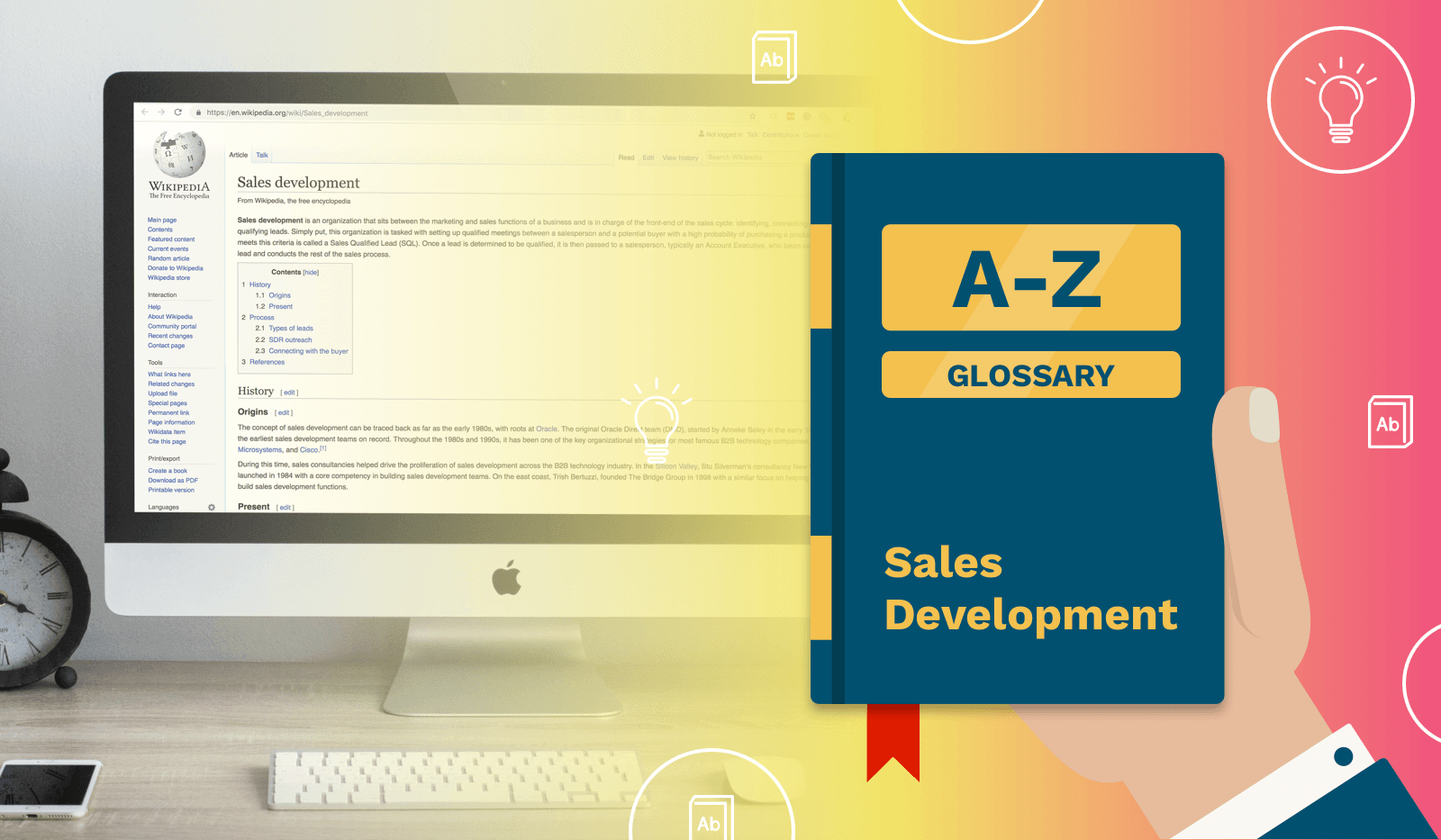Being ahead of the sales game means you are up-to-date with everything related to the subject: sales terms and vocabulary, industry news, and the hottest deals closed among others.
Knowing all the trends, new technologies, what books to read, and who to follow on social media… all that wouldn’t be of much use if you don’t understand the language and basic sales vocabulary used by sales development representatives.
So, to help you out, here is a list of the most commonly used terms by sales professionals today. Keep an eye on this article because we are going to update it every now and then with new terms and phrases to help you become a sales rockstar!
Let’s go back to the basics.
A – C
- Account Development Representative – a sales specialist in charge of attracting, qualifying, and securing new leads for further engagement and conversion
- Account Executive/AE/Closer – a sales team member in charge of closing deals; converting qualified leads into paying customers
- Account Manager/AM/Farmer – he or she is focused on managing and up-selling existing clients and accounts
- Business Development Representative – also known as a Sales Development Representative (SDR). This representative is a sales specialist focused on finding new prospects, establishing foundational relationships, and updating the sales pipeline with new leads.
- C-Level / C-Suite – highest level executives; C stands for Chief – like Chief executive officer (CEO)
- Champion – a client that is very satisfied with your product/service and customer support, so much so that they are ready to recommend you to other businesses
- Channel Partner – a person or company that offers services or products on behalf of another company.
- Channel Sales – focusing on different sales channels, such as an in-house sales team, retailers, referrals, dealers, etc.
- Churn – the percentage of clients that leave or stop using your services or products within a certain time period.
- Clients – Closed opportunities, paying clients and people that your account managers should take care of
- Closers – or Account Executives, are focused on closing deals and they only prospect a small number of strategic accounts.
- Cold Call – attempt to engage with a prospect (that whom you don’t yet have a relationship established) on a call
- Cold Email – engaging with prospects via email; sending a sales proposal to someone with that you don’t yet have a relationship with
- Customer Acquisition Cost (CAC) – the cost of acquiring new paying clients
- Customer Lifetime Value (CLV) – is also known as lifetime value (LTV). The total lifetime value of one client in terms of the revenue they’ll bring before they churn.
- Customer Relationship Management/CRM – a software or Internet-based service that helps business owners and sales professionals manage their sales pipeline; track prospects and related activities throughout the sales cycle
- Customer Success – a strategy and a proactive mindset that helps reduce churn rates, increase customer satisfaction with a service/product, and the predictability of recurring revenue
D – L
- Demand Generation – a marketing process with the purpose of building awareness about a company’s product or service
- Drip Campaign – automated email campaign usually consisting of several emails, that are sent out over a certain amount of time
- Fortune 500 – A list of 500 of the largest companies in the US based on revenue
- ICP – Ideal Customer Profile is a profile of an ideal client for your business
- In-Funnel Ping – a nudge email that you send out to qualified opportunities for the sake of keeping the relationship warm
- Inbound – interest that comes in (received cold emails, submitted forms..)
- Inbound Sales – sales that happen as a result of customers directly approaching and engaging with the brand/company
- Lead – a prospect that responded in a positive manner. This prospect has taken a specific positive action (for example replying to an email or registering for a webinar)
- Lead Generation – all of the activities that have a goal to generate interest around a product or a service through different methods – content marketing, PPC, referrals, outbound marketing, and partnerships
- Lead Nurturing – engaging and building a long-term relationship with existing prospects
- Lead Qualification – a process of identification and determining if the prospective client is in line with the company’s ICP
- Lead Scoring – assigning a value to every lead based on predefined criteria, in order to rank leads in terms of engaging priority
M – R
- Market Response Rep/MRR – inbound sales rep that is responsible only for qualifying leads that are coming in
- Marketing Qualified Lead (MQL) – a lead that will most likely become a paying client, based on what pages they visited, what action they took on the company website, and other online engagement
- Messaging – communicating your company and brand’s value proposition and what benefits you offer to your target audience
- Metrics – quantities used to determine – business profitability, assess an individual’s job performance, and among others help predict revenue and create actionable strategies
- Monthly Recurring Revenue (MRR) – the amount of regular and predictable income a company expects to receive every month
- Negotiation – a discussion between two or more parties with the aim of achieving a mutual agreement
- Net Promoter Score (NPS) – rating from 1-10 of customer satisfaction with the company and its product/service
- Nets – the third type of leads, ones that come through different marketing tactics – email marketing, conferences, advertising, and PPC
- Onboarding – a set of actions or a process of introducing a new client to a service or product. Setting up an account and introducing clients with their point of contact at the company
- Opportunities or Opptys – a qualified lead that is a good fit for your solution. An SDR has qualified this person as someone who fits your company’s Ideal Customer Profile
- Outbound Sales – cold calling, cold emailing, and social selling, with the goal of initiating contact with a prospective client and ultimately closing the deal
- Point of Contact – a person or a department within a company that the client can reach out to with questions or specific requests
- Predictable Revenue – a new sales framework created by Aaron Ross. This framework can help businesses create consistent year-over-year business growth. You can learn more about this unique system in our free course
- Prospects – a list of names and contact information in some type of list, database, or CRM
- Referral – method of generating new sales leads, where the third party refers a company to the potential new client
- Return on Investment (ROI) – is a metric, percentages, showing the percentage of efficiency of the initial investment. It is a ratio between net profit and the cost of investment.
- Revenue – the amount of money one business generates in a specific time period (a year, a quarter…)
S
- SDR – outbound sales representative; someone who is focused on generating and qualifying outbound leads.
- SaaS – an acronym for Software as a Service
- Sales Acceleration – speeding up the sales process using different tools and technologies to boost productivity and efficiency
- Sales Automation – a process of automating sales workflow by using software or an online tool. It can help simplify, speed up and streamline the sales process
- Sales Cadence – a determined sequence of sales activities and the frequency at which the sales team interacts with leads
- Sales Champion – is a client that is so satisfied with a company and its service/product that is more than willing to advocate for total implementation fo
- Sales Coaching – helping sales professionals develop new skills, improve their performance and efficiency
- Sales Cycle – predictable sequences and stages that a company goes through as they sell their product or service
- Sales Demo – an event that serves as a showcase of the product or service that the company is selling
- Sales Development Representative – or an SDR; sales representative focused on prospecting and finding new sales opportunities
- Sales Director – senior-level executive that oversees the sales team’s operations by formulating strategies, approving department budget, supervising regional managers and makes sure that the company sales growth trend is going up
- Sales Enablement – providing sales professionals with necessary tools, technology, training, and other resources in order for them to have better performance at customer engagement
- Sales Funnel – a visual representation of sales processes with defined stages, that every potential client goes through as they are let towards a final decision – buying a product or service
- Sales Kickoff – an annual event that companies often organize to talk about achievements, revenue, and goals and strategies for the next year
- Sales Lead – a potential customer of the company; they might have expressed interest in the company or shared their contact information
- Sales Manager – a person in charge of a sales team, sales department in charge of implementing strategies and making sure that the goals are met. They also take care of developing successful salespeople
- Sales Operations – a set of activities that one sales team has and follows so the sales processes run smoothly, efficiently and in line with the overall company business strategy
- Sales Partnerships – relationship established between individuals and organizations to boost sales performance with the mutual goal in mind
- Sales Pipeline – a visual representation of a sales process and stages of each individual prospect
- Sales Process – set of activities that are aimed at driving sales growth – tactics, methodology, and technology that can help
- Sales Productivity – metric that indicates how good a salesperson or department is at closing deals and generating revenue for the company
- Sales Prospect – a qualified sales lead or a potential client that fits ICP of the company and will most likely become a paying client of the company
- Sales Prospecting – a process of finding and identifying new prospecting clients using different outbound methods – cold email, social selling, advertising etc.
- Sales Qualified Lead (SQL)- a potential client that already met all the necessary criteria, and is forwarded to Account Executive to close the deal
- Sales Training – a process of improving sales skills, learning new trends and technologies that can help improve sales
- Scraping – extraction of large amounts of data from websites
- Seeds – according to Aaron Ross, the author of the Predictable Revenue book, one type of leads are seeds. These are leads that come to the company through word of mouth, PR campaigns, and referrals. It takes time to generate enough of these leads, but in the end, they have the highest conversion and close rate.
- Segmentation – a process of dividing a large market or a contact list into smaller segments based on different criteria – location, company size, revenue etc.
- Social Selling – a sales tactic that involves using social media as a sales channel. SDRs engage and create relationships with prospects by probing their needs and providing relevant and valuable insight.
- Spears – the second type of leads according to Predictable Revenue are spears, leads that are acquired through targeted outbound sales efforts
T- W
- Top of the Funnel – a term that refers to the top of the sales or marketing funnel, where all prospects go through a qualification process, both from inbound and outbound efforts
- Unicorn – a startup company valued at over $1 billion
- Unique Selling Point/Proposition – unique features of a business that sets it apart from the competitors
- Vertical – a specific segment of the market where a business targets only a specific industry, sector or niche.
- White Label – a product or service that one business creates, and other businesses rebrand and sell as their own. This scenario is for the mutual benefit of all participants.



